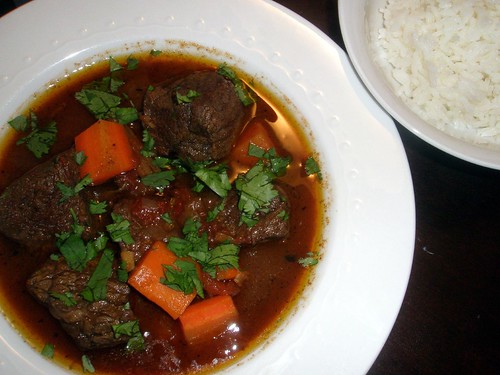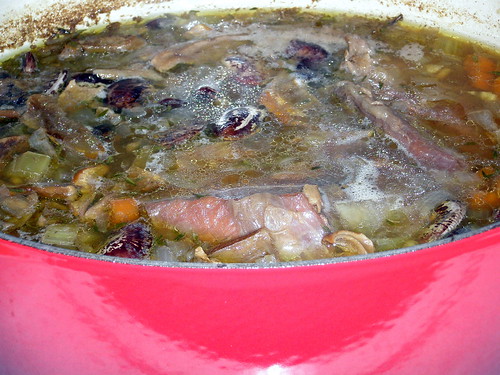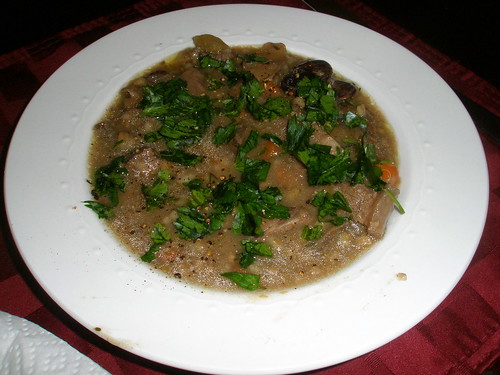Showing posts with label beef. Show all posts
Showing posts with label beef. Show all posts
Sunday, February 27, 2011
The Final Countdown begins with Pho
I recently received the exciting news that I will be leaving New York in six months to become a full-time student for the next two years in a place that is a very far cry from New York. While I am ecstatic to begin this new chapter in my life, I am going to be sad to leave behind all the people, places, and activities that have made my five years in New York so special, so like a person who's been told he has six months to live (and for me, the thought of enduring two years of cafeteria food and microwave dinners feels a bit like that), I have created a list of things to do before I leave this great city. While my list includes a lot of special, only in New York activities (picnic in Central Park, run around the island of Manhattan), it also includes a category of items that most New Yorkers would not dare do: "Challenging Foods to Cook!" In six months, I'll not only to be kitchen-less, but I'll also have limited time to do much cooking, so I have decided to try to make an effort all those foods that I have always wanted to make, but never made the time or the effort to cook.
First up on my cooking list was pho, the Vietnamese soup. After making it, I realized that making pho is not at all the challenge I assumed it would be, although after about four hours of preparing it plus a couple more hours wandering the streets of Chinatown in search of the right ingredients, a $5 bowl at a pho joint seems like an even better deal. I made pho bo, or beef pho, using thin slices of cooked brisket and raw sirloin, but the technique for pho ga (chicken pho) is fairly similar.
The first step to a great pho is to char the skins of the onions and ginger that go into the broth. If you don't have a hood or a well-ventilated kitchen, it's best to do this step under a broiler or outside on a grill. If you do, or you don't like me, but know you will be moving out of your apartment in six months, you can roast the vegetables over an open flame. You want to char the ginger and onions completely, about 15 minutes, turning them frequently as they roast. Once they are done, let them cool down. Rinse the vegetables under cool water, peeling off the charred skins.
The central component of pho broth is, of course, the beef bones. I used about 5 pounds of 2-inch thick shin bones. The first thing you'll want to do is to boil the bones in water for a few minutes, which will remove some of the impurities from the bones, allowing for a clearer broth. Once boiled, drain the bones.
To make the broth, you combine the beef bones, the onions and ginger, a cinnamon stick, a spoonful each of cloves, star anise, sugar, and salt, a generous pour of fish sauce, and thick strips of brisket with six quarts of water. Allow this mixture to simmer for an hour and a half. Then, remove the brisket and continue simmering the broth for another hour and a half. Drain the broth through a fine mesh sieve and refrigerate it overnight so that the fat solidifies. The following day, remove the fat from the broth.
The day that you plan to serve the pho, prepare all of the condiments and set them on the table. Lime juice, Thai basil, mint, blanched bean sprouts, Sriracha sauce, and hoisin are all go nicely with pho.
Once the broth is ready, prepare the bowls: boiled rice noodles, scallions, cilantro, thinly slice onions, thinly sliced cooked brisket, and thinly sliced raw sirloin. Then pour the hot broth on top of it all. It's perfection in a bowl.
Monday, January 17, 2011
Ribeye with Thyme, Shallot, and Garlic Pan Sauce
Friday, April 30, 2010
Grazin' Angus Acres Beef Jerky
The other day, I made the embarrassing admission to Significant Eater that I had never eaten beef jerky. Call me a snob, but I just never understood the appeal of eating packaged, dried beef. When I spotted beef jerky sold at Grazin' Angus Acres, a grass-fed beef purveyor at the Union Square Greenmarket (that also happens to sell the best eggs at the Greenmarket), I knew that I finally had to give beef jerky a try. A grass-fed, local, artisanal, $10 for a quarter pound beef jerky that needs to be refrigerated? Ok, well maybe I am a bit of a snob, but this beef jerky is pretty good stuff. It's intensely spiced and the leathery texture that I assume is inherent to all beef jerky is not as off-putting as I expected it to be. According to Significant Eater, Grazin' Angus' beef jerky tastes just like a Slim Jim. I wouldn't know, but if that claim is accurate, I may just have to snap it to a Slim Jim one of these days.
Sunday, December 27, 2009
Short Ribs alla Genovese
These short ribs from A16: Food + Wine embody much of what this blog is all about: making the most of just a little bit. In this case, that little bit is ingredients, of which this recipe contains only a handful, and almost all of which are probably already in your kitchen. The recipe truly does make the most of these ingredients, for the braising liquid is as robust as any. Two days after the short ribs were long gone, I used the leftover braising liquid, which is chock-full of sauteed red onion, and made a meal of the liquid poured over freshly cooked polenta, once again making the most of just a few ingredients.
embody much of what this blog is all about: making the most of just a little bit. In this case, that little bit is ingredients, of which this recipe contains only a handful, and almost all of which are probably already in your kitchen. The recipe truly does make the most of these ingredients, for the braising liquid is as robust as any. Two days after the short ribs were long gone, I used the leftover braising liquid, which is chock-full of sauteed red onion, and made a meal of the liquid poured over freshly cooked polenta, once again making the most of just a few ingredients.
Short Ribs alla Genovese
Adapted from A16: Food + Wine
Ingredients:
Directions:
Short Ribs alla Genovese
Adapted from A16: Food + Wine
Ingredients:
- 4 meaty, bone-in short ribs
- Kosher salt
- 4 tbsp olive oil
- 1 1/2 cups dry red wine
- 1 small carrot, peeled diced
- 1 celery stalk, trimmed and diced
- 5 anchovy fillets, minced
- 2 cloves garlic, peeled and crushed
- 5 black peppercorns
- 3 red onions, thinly sliced
- 3 tbsp red wine vinegar
- 1 sprig rosemary
Directions:
- At least an hour prior to cooking, remove the short ribs from the refrigerator. Trim any excess fat from the ribs and season them well with salt.
- Preheat the oven to 275F.
- In a small saucepan, boil the wine until reduced to 1/2 cup. Set aside.
- Heat 2 tbsp olive oil in a large Dutch oven over medium-high heat. Add the ribs to the Dutch oven and cook until well-browned on all sides, 8 to 10 minutes. Do not crowd the ribs; if necessary, cook them in two batches.
- Remove the ribs from the pan and set aside on a plate. Pour out the fat from the pan and wipe out any burnt bits from the pan with a paper towel.
- Add the remaining 2 tbsp of olive oil to the Dutch oven and heat over medium heat. Add the carrot and celery and cook until they are soft and beginning to brown, about 5 minutes, adjusting the heat of the pan as necessary.
- Stir in the anchovy, garlic, and peppercorns and continue and cook for 3 minutes, stirring occasionally.
- Add the onions and a pinch of salt to the pan and cook until the onions are soft and translucent, 5 to 10 minutes.
- Stir in the reduced red wine and the vinegar with the vegetables and remove the pan from the heat.
- Add the short ribs to the pan, nestling them into the vegetables meat side facing down. Wedge the rosemary sprig between the short ribs.
- Cover the Dutch oven and place it in the 275F oven. Cook until the short ribs are tender and falling off the bone, approximately 2 1/2 hours. Serve the ribs over polenta topped with the braising liquid.
Labels:
A16: Food and Wine,
beef,
Italian,
recipe,
shor ribs
Tuesday, October 20, 2009
Bo Kho Vietnamese Beef Stew
Bo kho, a traditional Vietnamese beef stew made with tomato, star anise, and lemongrass, from Andrea Nguyen's Into the Vietnamese Kitchen :
:


Labels:
Asian,
beef,
Into the Vietnamese Kitchen,
stew,
Vietnamese
Monday, May 18, 2009
Flap Steak with Red Wine and Shallot Sauce

Ever since reading Michael Pollan's The Omnivore's Dilemma, I have been tempted to try grass-fed beef. After all, most of my diet consists of local, minimally processed foods, so grass-fed beef would be a logical addition. It's more nutritional and more environmentally-friendly than grain-fed beef, and the theory goes that grass-fed cows are happier since they're digestive systems are made for eating grass, not grain. However, critics say that grass beef is lacking in both flavor and texture to it's grain-fed brethren; plus it's more expensive. In supermarkets, most of the grass-fed beef I see has been shipped in from Australia, which defeats the Mr. Pollan's message to eat grass-fed beef. Taking all of this in mind, my home-cooked steaks have always been from grain-fed cows.
This past weekend, I finally decided to give grass-fed beef a try while passing the Grazin' Angus Acres stall at Union Square Greenmarket. Initially, I had only planned to purchase some of their amazing eggs. But then my eyes turned to the farm's core competency, grass-fed beef. If Grazin' Angus Acres' beef was only half as good as their eggs, I might finally jump onto the grass-fed bandwagon.
Not wanting to risk all of my Greenmarket budget on a piece of meat, my eyes wandered to the cheaper options that Grazin' Angus Acres had for sale: flank, skirt, and flap steak, all of which were in the respectable $13 to $15 per lb. range. The woman at the stall suggested the $13 per lb. flap steak, so I picked up two nice pieces, and returned home with my Greenmarket tote bag held up high in my self-righteous grass-fed glee.
As with most foodie splurges, I was determined not to screw up my foray into grass-fed beef. Upon returning home, I researched how to cook flap steak, a an ill-named cut with which I was unfamiliar. Thanks to know-it-all Wikipedia, I found out that flap steak is a cut similar to hanger steak, coming from the bottom of the sirloin butt. From, there, it was onto finding a suitable recipe that would push me over the edge of the "I'd rather be a vegetarian than eat grain-fed beef" trend. I found this recipe for flap steak with red wine and shallots from the San Francisco Chronicle; with a whole stick of butter in the sauce, it seemed like it would be difficult to screw up my meat with this recipe.
I was impressed with my first taste of grass-fed beef. The beef does indeed have a unique flavor; it's much more gamy than grain-fed beef, but it's just as flavorful. Since flap steak is inherently a tougher cut, I can't be a judge of whether grass-fed beef is less tender than grain-fed, but I will say that my flap steak was just as tender as any grain-fed hanger steak I have eaten. I cooked it to a perfect medium-rare (the picture makes it look more cooked), which I read is important with grass-fed beef; overcooking it will make the meat very tough.
So am I sold on grass-fed beef? My steak was delicious, and its flavor differed from that of grain-fed beef. However, in the end I owe its deliciousness more to the good farming methods of Grazin' Angus Acres than to its grass-fed powers. As with any food, beef's flavor is more about how it is raised than what it is raised on. While all things being equal, I will try my best to choose grass-fed beef for all of its earth friendly good qualities, I will always choose my beef based on it being a good product rather than what the cow has been fed.
Labels:
beef,
dinner,
grass-fed,
Grazin' Angus Acres,
recipe
Wednesday, March 4, 2009
Christmas Lima Bean Soup with Short Ribs and Porcini Mushrooms
I’m not sure why I don’t make soup more often. Generally, soup is:
- Easy
- Cheap
- A good way to use up neglected items from the pantry and fridge
- Still delicious when reheated (and soup makes plenty of leftovers to reheat)
- Difficult to screw up
Most of the above can also describe braised dishes, my favorite dishes to cook, but for whatever reasons, I rarely make soups. Last week a recipe for Lima Bean and Porcini Soup that appeared in the New York Times caught my eye because it looked simple enough and would require only a short trip to the store. I decided that for once, I would tackle a soup recipe.
I made a few substitutions based on what I had on hand, using excellent Rancho Gordo Christmas Limas in place of traditional lima beans and short ribs in place of beef shanks. Also, my beans took nearly two hours to cook (due to not being soaked for long enough, I imagine), so the soup had more of a stew consistency than that of a soup. Nonetheless, the earthy, meaty flavors of the lima beans and mushrooms combined with the short ribs produced a hearty soup. Despite the Nor’easter that would be dumping snow upon New York later that night, this soup made me slightly sad that winter was almost over and that time was running out to try more soup recipes.
Here is the soup in the pot:

And in the bowl:

- Easy
- Cheap
- A good way to use up neglected items from the pantry and fridge
- Still delicious when reheated (and soup makes plenty of leftovers to reheat)
- Difficult to screw up
Most of the above can also describe braised dishes, my favorite dishes to cook, but for whatever reasons, I rarely make soups. Last week a recipe for Lima Bean and Porcini Soup that appeared in the New York Times caught my eye because it looked simple enough and would require only a short trip to the store. I decided that for once, I would tackle a soup recipe.
I made a few substitutions based on what I had on hand, using excellent Rancho Gordo Christmas Limas in place of traditional lima beans and short ribs in place of beef shanks. Also, my beans took nearly two hours to cook (due to not being soaked for long enough, I imagine), so the soup had more of a stew consistency than that of a soup. Nonetheless, the earthy, meaty flavors of the lima beans and mushrooms combined with the short ribs produced a hearty soup. Despite the Nor’easter that would be dumping snow upon New York later that night, this soup made me slightly sad that winter was almost over and that time was running out to try more soup recipes.
Here is the soup in the pot:

And in the bowl:

Subscribe to:
Posts (Atom)

















